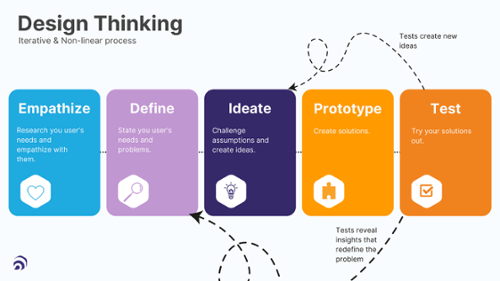Art and science in Design Thinking
Design is an important element for all companies. It is related to aesthetic as well as technical and strategic aspects, since it does not remain...
It is easy to say that thinking outside the box allows us to solve complex problems innovatively, but putting it into practice can be a big challenge as we fall into repetitive thinking patterns. It is difficult to challenge everyday assumptions.
However, Design Thinking and its focus on an iterative process with constant questioning forces us to challenge those assumptions and gain new insights, redefining the problem, strategies, and solutions.
Index
What is Design Thinking?
Design Thinking is more than a process; it is a way of thinking that provides a solution-based approach to creative and collaborative problem solving through a collection of practical methods and an iterative process that seeks to understand users.
In essence, Design Thinking:
Blog of interest: Introduction to Design Thinking

Design Thinking Process
Just as there is no single solution to the problems we want to solve through Design Thinking, there is no single way to practice the process. Currently, there are several frameworks for Design Thinking, which have different names and stages; however, they all contain the same bases and consist of the same principles.
For example, one of the first versions of the Design Thinking process is that of Herbert Simon, which consisted of 7 stages: Define - Investigate - Ideate - Prototype - Choose - Implement - Learn.
On the other hand, there are simpler versions, such as AIGA, consisting of 3 stages: Solve - Empathize - Create. These are visually represented by the head, the heart, and the hands.
In this blog, you will see the Stanford School of Design d.school model; they teach an iterative and non-linear process conformed by five stages: Empathy - Definition - Ideation - Prototyping - Testing.

The most important thing is understanding that "iterative and non-linear process." That phrase means that the executing team can use the result of one stage to evaluate and improve a previous step. This allows understanding the problem and redefining it when necessary, and creating new insights and alternative solutions that had not been thought of before.
Thinking outside the box
Design Thinking helps people think differently and from a new perspective. People who use this methodology develop the ability to:
Blog of interest: Generating successful solutions with Design Thinking

Design Thinking applications
Applying Design Thinking allows:


Design is an important element for all companies. It is related to aesthetic as well as technical and strategic aspects, since it does not remain...

We face challenges that test our creativity and ingenuity every day, so we must generate ideas to address various challenges. However, only some of...

Do you know what the world's largest media and entertainment conglomerate, aka Disney, digital accommodation platform Airbnb, management systems...